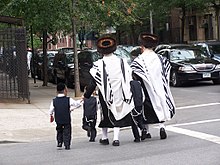| Part of a series on |
| Race and ethnicity in New York City |
|---|

Since its founding in 1625 by Dutch traders as New Amsterdam, New York City has been a major destination for immigrants of many nationalities who have formed ethnic enclaves, neighborhoods dominated by one ethnicity.[2][3] Freed African American slaves also moved to New York City in the Great Migration and the later Second Great Migration and formed ethnic enclaves.[4] These neighborhoods are set apart from the main city by differences such as food, goods for sale, or even language. Ethnic enclaves provide inhabitants security in work and social opportunities,[2] but limit economic opportunities, do not encourage the development of English speaking, and keep immigrants in their own culture.[2]
As of 2019[update], there are 3.1 million immigrants in New York City. This accounts for 37% of the city population and 45% of its workforce.[5] Ethnic enclaves in New York include Caribbean, Asian, European, Latin American, Middle Eastern and Jewish groups, who immigrated from or whose ancestors immigrated from various countries. As many as 800 languages are spoken in New York.[6][7][8]
- ^ Weichselbaum, Simone (June 26, 2012). "Nearly one in four Brooklyn residents are Jews, new study finds". Daily News. New York. Archived from the original on July 4, 2018. Retrieved May 30, 2013.
- ^ a b c Lorren, Johns (December 14, 2006). "Ethnic enclaves: Lost in their own world?". writing.byu.edu. Brigham Young University. pp. 4–5. Archived from the original (PDF) on October 6, 2011. Retrieved April 20, 2009.
- ^ "The New Netherland". U-S-History.com. Retrieved May 16, 2009.
- ^ Cite error: The named reference
great1was invoked but never defined (see the help page). - ^ "State of Our Immigrant City" (PDF). New York City Mayor's Office of Immigrant Affairs. Retrieved August 4, 2020.
- ^ "Endangered Language Alliance". 2012. Retrieved March 10, 2014.
- ^ "Linguistics- Say what?". The Economist. September 10, 2011. Retrieved March 10, 2014.
- ^ N. R. Kleinfield (January 15, 2016). "New Yorkers, Self-Assured and Opinionated, Defend Their Values". The New York Times on MSN. Retrieved January 15, 2016.